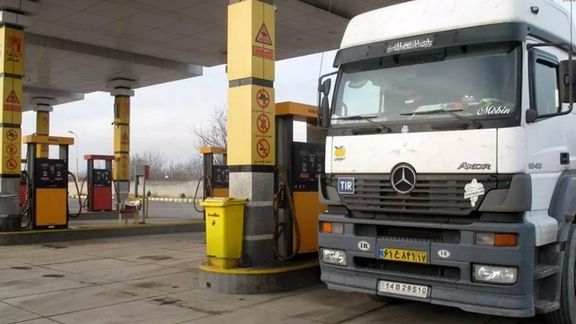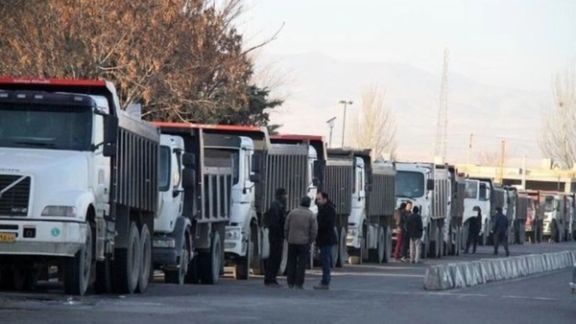Iran Postpones Tighter Fuel Rationing Fearing Renewed Mass Protests

Iran's government has postponed the implementation of tighter diesel rationing as the anniversary of last year's anti-regime protests is approaching in September.

Iran's government has postponed the implementation of tighter diesel rationing as the anniversary of last year's anti-regime protests is approaching in September.
Iran International has obtained information that the security organs have advised the government to delay the implementation of its plan to decrease the fuel quota for diesel-powered vehicles until after the death anniversary of Mahsa Amini, who was beaten to death by the hijab police in September 2022. The tragic event ignited months of protests that became the boldest uprising against the regime since its establishment in 1979.
Informed sources told us that the administration of Ebrahim Raisi planned to introduce a tight rationing system aimed at reducing diesel consumption by 25 percent, adding that security officials deemed the possible protests and strikes by truck drivers "dangerous" in the current situation.
Truckers, who do the heavy lifting of transporting goods mainly to and from Iran’s border areas and ports across the country, have already held several rounds of weeks-long strikes that brought the flow of goods and the supply chain to a grinding halt. Prices of fuel and equipment are already among their numerous grievances amid high inflation, and the regime seems unable to cope with new rounds of union action that can take place.

Reza Gheibi, an economic journalist, told Iran International Tuesday that the Raisi administration’s plan to remove subsidies for essential goods last year has already taken its toll on the consumer market, with food prices recording the highest rate of inflation. Earlier in the day, the price of bread in Iran’s northeastern Razavi Khorasan province increased by 40 percent, triggering concerns that a similar price hike will be implemented across the country.
The regime, which has one of the world's largest oil and gas reserves, sells gasoline and diesel at extremely low, subsidized prices, charging less than 10 US cents for gasoline per gallon, or less than 3 cents per liter, while that of diesel is even 50 percent lower. Second only to Venezuela, Iran has the world’s cheapest gasoline price.
For years there has been talk of adjusting prices, but since 2018 Iran’s currency has dropped 12-fold and any increase needs to be huge to be meaningful in US dollars. However, fuel price hikes risk fanning the flames of further unrest. Before the regime dares to raise the prices in line with international market rates, it is inching towards decreasing its expenditures on fuel subsidies via curbing consumption, thus the policy of stricter rationing.
According to Gheibi, changes in the prices or quotas of diesel are even more sensitive than gasoline because of its consequences for the country’s transportation fleet.
The managing director of the National Iranian Oil Refining and Distribution Company said earlier in July that a total of 220 million liters of liquid fuel (gasoline and diesel) are used by the transportation fleet per day in Iran. Jalil Salari added that “If only this consumption volume were to be reduced by 10%, it could be spent on replacing the aging transportation fleet and infrastructure as well as in the oil industry.”
Amid reports of imminent fuel price rises and stricter rationing, the regime has put an unknown number of fuel stations on security alert and is conducting security drills in the middle of the night.
In November 2019, a government decision to increase fuel prices by 50–200 percent triggered a cycle of protests and unrest across the country that lasted for over two weeks. During this time, at least 1,500 civilians were killed by security forces.
Earlier this year, it started piloting a new plan in a number of small cities according to which citizens are still allowed to buy 60 liters (15.8 US gallons) of gasoline per month at the cheap price of 15,000 rials per liter, or less than 3 US cents. The new plan reportedly caps the premium gasoline at 150 liters (40 gallons) per individual per month.
In addition to extremely low prices that do not encourage saving fuel, Iran also faces gasoline and diesel shortages due to a lack of refining capacity. The low prices also lead to millions of liters of fuel being smuggled out of Iran daily, part of a large-scale global smuggling network. Iran’s heavy subsidies for fuel and electricity cost the country at least $50 billion a year, while the government struggles to secure foreign currencies amid US economic sanctions.
While the country is hugely dependent on revenues from crude oil exports, due to sanctions and mismanagement, it has failed to modernize the energy sector in general, with power shortages most of the year. Systemic corruption also further cripples the weak system.
The situation has been grave in recent years but since the administration of Ebrahim Raisi assumed office in 2021, the entire energy management system is going haywire even faster, drawing backlash from not only the public but even regime officials.